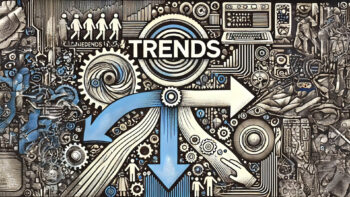
Are you a Trend Setter or a Trend Follower?
Exactly what is a Trend?
By Jim Nowakowski
(special to KB-Resource)
Aristotle said we should define our terms, so before deciding if you are a trend setter or follower, let’s define what exactly is a “trend.” Basically, a trend is “a general direction in which something is developing or changing.”
That’s not really helpful, because everything changes all the time. Heraclitus the Greek philosopher said all things are flowing — you cannot step twice into the same river.
So by definition, a trend is something that more than one person does. Shaking hands was a trend before COVID, and then became less than a trend after the virus broke out.
It’s important for architects, designers, and the rest of us to not only understand what a trend is, but how a trend affects us, or doesn’t. In fact, it’s probably really important to understand how trends start, if we should follow them, if we should rate them. Because trends come and go, don’t they?
This essay is about understanding the root causes of trends in business: fashion, construction, architecture and interior design. Since trends shape these industries – eventually influencing what consumers buy, how spaces are designed, and even how businesses operate – being able to spot the ones that will last as opposed to those that don’t is important to our thinking and survival in business.
While trends can seem spontaneous, they often have identifiable root causes – causes that come from 1) societal shifts, 2) technological advancements, and 3) cultural influences. These three root causes drive trends, so understanding these underlying forces is essential for businesses to stay relevant and competitive – and for us to keep our sanity (i.e., think about a pair of Balenciaga Triple S sneakers having an average resale price of $1,162 U.S. dollars worldwide according to Statista. Who would have thought gym shoes would be such an expensive “trend.”)
This essay explores the root causes of trends in various industries of fashion, construction, architecture, and interior design.
Societal Shifts: Reflecting Changing Values
One of the most obvious drivers of trends across industries is the evolution of our values which come from our society. As cultural norms, lifestyles, and priorities shift, industries adapt by introducing new trends that echo these changes.
In fashion, for example, societal shifts around gender identity, sustainability, and inclusivity have had an acute impact on the trends people follow. The rise of gender-neutral clothing, for instance, reflects broader conversations about identity and acceptance. And you can immediately see that you don’t have to “agree” with a trend for it to be a trend; in fact, for every trend that arises, there’s usually a counter trend that shows up. In the end, these “driving forces” from society shifts cause changes and confusion, just like Heraclitus talked about!
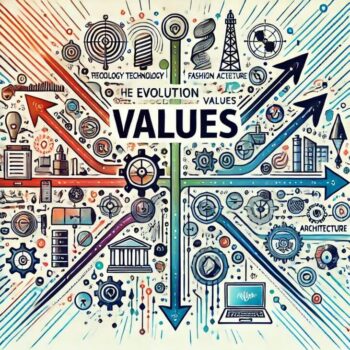 Sustainability is another example of a society trend that has also become major recently, with consumers increasingly favoring eco-friendly fabrics and ethical production processes as awareness of environmental issues grows[1]. The fact is, sustainability is a topic that has erupted in most markets; in Finding a Working Definition for Sustaining Sustainability, it was noted, “A brand’s regulatory competence with sustainability should be embraced throughout the C-suite and integrated across functions according to sources, whether you are selling lighting, plumbing, HVAC or other building-related products.” The piece then asked the critical questions: “But how does the marketer navigate sustainability for the brand? What is the real working definition of the word?” The answers depend a lot on what you see as “trends within the trend.”
Sustainability is another example of a society trend that has also become major recently, with consumers increasingly favoring eco-friendly fabrics and ethical production processes as awareness of environmental issues grows[1]. The fact is, sustainability is a topic that has erupted in most markets; in Finding a Working Definition for Sustaining Sustainability, it was noted, “A brand’s regulatory competence with sustainability should be embraced throughout the C-suite and integrated across functions according to sources, whether you are selling lighting, plumbing, HVAC or other building-related products.” The piece then asked the critical questions: “But how does the marketer navigate sustainability for the brand? What is the real working definition of the word?” The answers depend a lot on what you see as “trends within the trend.”
For example, when it first showed up, sustainability thinking thought floors should be made of cork. That trend lasted a few hours, as flooring with cork doesn’t work very well. So a “trend” itself has to have a combination of functionality, design, and acceptance, as well as other characteristics that in fact determine how long the trend lasts.
Similarly, sustainability in architecture and interior design created a focus on eco-friendly living, with movements emphasizing minimalism, energy efficiency, and the use of natural materials. For example, the increasing popularity of “tiny homes”[2] and open-floor layouts in residential construction can be traced back to shifts in lifestyle preferences towards simplicity and sustainability.
In construction, the trend toward smart buildings, with integrated energy-saving technologies, reflects society’s growing concern with environmental issues and efficiency. The push for LEED® (Leadership in Energy and Environmental Design) certification in buildings was another response to the demand for greener spaces[3].
Technological Advancements: Innovation Driving Change
Technological advancements turn out to be another crucial factor in shaping trends. As new materials, tools, and systems emerge (just think about 3D printing for a moment), industries must adapt, often giving rise to even more trends affecting the first two (society and sustainability) that capitalize on the latest innovations. Heraclitus’ river keeps flowing once again.
In fashion, as an example of technology advances, the introduction of synthetic fabrics such as polyester and nylon revolutionized the industry, enabling new styles and mass production methods. Today, 3D printing and wearable technology are driving the next waves of trends, offering customization and functionality never before possible[4].
In architecture and construction, Building Information Modeling (BIM) reshaped how projects are designed, managed, and executed, making construction more efficient and cost-effective while allowing for more complex and innovative designs[5]. The entire Design Build movement emerged as a result. The ability to construct high-performance buildings using again 3D printing and prefabrication technology has also given rise to new trends in sustainable, modular, and scalable architecture. Trends seem to be circular.
In interior design, technological innovations in smart home systems, lighting, and even furniture design have fueled the trend toward “connected living”—where digital technologies seamlessly integrate into the design of living spaces. Automated lighting, heating, and entertainment systems are now becoming standard features in modern homes, creating new expectations and demands in design.
Economic Factors: Demand and Supply Dynamics
Economic conditions also play a significant role in shaping business trends. In periods of economic boom, as an example, consumers are more willing to invest in luxury products and services, leading to the rise of high-end trends[6]. Conversely, during recessions or economic downturns, there is often a shift towards cost-efficiency, practicality, and affordability[7]. It moves, just like a river, doesn’t it? And that’s just the situation we all find ourselves in today regardless of market – whether it’s boom or bust times.[8]
For instance, in fashion, economic downturns typically lead to trends in minimalist and versatile clothing. The 2008 financial crisis spurred the rise of fast fashion, with brands like H&M and Zara thriving by offering trendy clothing at low prices. Similarly, architecture and construction trends often reflect economic cycles. During economic expansions, we see more daring and luxurious projects, such as high-rise towers and expansive residential complexes. In contrast, periods of recession lead to smaller-scale projects and a focus on cost-cutting measures, such as the use of prefabricated materials and streamlined designs.
Interior design trends also adapt to economic changes. When times are tough, designers focus on functionality and cost-effective solutions, leading to trends like multipurpose furniture, smaller living spaces, and DIY aesthetics. On the other hand, in periods of affluence, there is a tendency toward lavish, high-end designs with an emphasis on exclusivity and craftsmanship. There’s just something about the Heraclitus river, isn’t there?
Cultural and Artistic Influences: The Power of Aesthetics
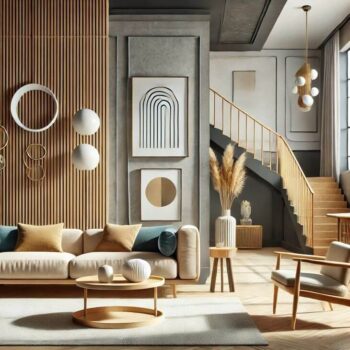 Cultural movements and artistic developments are often powerful drivers of trends across industries, taking their cue from the social, economic and technological movements going on in the culture. In fashion, as an example, the influence of streetwear culture, hip-hop, and global artistic movements has shaped collections, styles, and color palettes. Similarly, in architecture, trends such as modernism, brutalism[9], and postmodernism arose from broader artistic and intellectual movements that questioned traditional norms and embraced new forms of expression.
Cultural movements and artistic developments are often powerful drivers of trends across industries, taking their cue from the social, economic and technological movements going on in the culture. In fashion, as an example, the influence of streetwear culture, hip-hop, and global artistic movements has shaped collections, styles, and color palettes. Similarly, in architecture, trends such as modernism, brutalism[9], and postmodernism arose from broader artistic and intellectual movements that questioned traditional norms and embraced new forms of expression.
In interior design, trends often reflected historical revivals or reinterpretations of classic aesthetics, such as the resurgence of mid-century modern furniture or the popularity of art deco-inspired spaces. The global influence of Scandinavian design that emphasizes simplicity, functionality, and natural materials, has also shaped interior design trends worldwide.
The circular nature of trends is another key point to keep in mind. Fashion, architecture, and design are inherently circular, with styles and concepts from previous decades reemerging in new, updated forms. This phenomenon is evident in fashion, where ‘90s nostalgia has brought back trends like oversized denim and bold logos, and in architecture, where industrial styles from the 20th century are being revived and reinterpreted in modern spaces.
So Now What?
In this article we demonstrated that trends in fashion, construction, architecture, and interior design are shaped by a complex interplay of societal shifts, technological advancements, economic factors, and cultural influences. As these forces evolve, businesses must remain attuned to the changing landscape to stay relevant. This is especially true in ALL categories in B2B.
On Thursday, September 5, 2024 at 2:00 PM, Joe Trave, Founder and CEO of Village Handcrafted Cabinetry hosted a KCMA® webinar entitled Design Trends. Featuring a panel of three top designers, the session covered the trending going on in the world of kitchen cabinet design. The panel was comprised of Natalia Pierce, CMKBD, Well AP, the owner and designer of Detail by Design who was also the KCMA Designer of the Year; Nissa Cardell, Senior Designer at Village Handcrafted Cabinetry; and, Kerstin Morey, the owner and designer at The Material Bar.
How did what these professionals talk about reflect the trends in fashion, construction, architecture, and interior design are shaped by a complex interplay of societal shifts, technological advancements, economic factors, and cultural influences? What can we learn from their discussion that can help us make our own evaluation about our businesses?
The session kicked off with a discussion about frame versus frameless in cabinets. Deciding between these two depends, certainly, on the trend being followed at the time, which is what the discussion brought out.
For example, Kerstin Morey pointed out that frameless was about “an efficient, clean more contemporary look.” While her company is doing more framed work, they are primarily a frameless market.
Natalia Pierce said they are focused on the European influence and do “all frameless with no framed. There’s just not a lot of requests for framed…the consumer is looking at what they can get for the dollar value.”
Nissa Cardell, whose studio is located close to Philadelphia, said that there are many “historical homes here, and cabinetry is built into the homes. We’re doing a lot of insets, and framed quite honestly, but we do mostly insets. Even if we do frameless, they want it to look framed.”
Just from these three points of view we see immediately that designers respond to the market – to shifts in consumer values, leveraging the latest innovations, or adapting to economic conditions. In point of fact, they “give the customers what they want” and ADAPT the trends to the market. While they maintain high awareness of the latest movements in trends, what was clear is that these professionals survive by giving their customers what they want, drawing on their extensive backgrounds of their profession.
As a result, they understand the root causes of trends and are better positioned to anticipate and respond to new developments, driving their success in fast-changing markets.
White
Another example of how markets drive trends occurred when the discussion moved to the color white, which according to the panelists “many designers ‘cringe’ at when a customer walks in wanting it.” However, the conversation evolved to admit that there are different shades of white, especially when the discussion jumped to white oak.
Pierce said, “Oak used to be the pinnacle to show success, but white oak has that beautiful, softer look and the latest trend is white oak.”
Morey agreed. “There’s a huge ask for white oak. But we’re also using laminates as substitutes.” The panel also noted that the supply of white oak is driving the cost up 70% from two years ago. Cardell noted, “what is the consumer buying, that’s the key. Will white paint ever go out? Probably not. It’s a safe color, and people are afraid to commit to a color.”
Industry Up Close
One of the discussion points was the trends they saw at KBIS® 2024. KBIS, of course, is the Kitchen & Bath Industry Show (KBIS) and positions itself as North America’s largest trade show dedicated to all aspects of kitchen and bath design. In conjunction with the National Kitchen & Bath Association (NKBA), the show states that it is “an inspiring and interactive event that showcases the industry’s latest products, trends, and technologies from hundreds of exhibitors.”
But if you’ve ever attended this show or others that position themselves as showcasing the latest trends, your eyes will blur over after about an hour. It’s not that there’s nothing new; it’s that how much “new” can you digest!
These panelists pointed out a number of areas that attracted them as “trends.” Kerstin Morey perhaps summed it up: “There were a lot of fun vendors who introduced panels, specialty vendors showing round ends added to islands. Lots of arches. Round is seeing a comeback. That went out of style twenty years ago; what comes around and goes around (no pun intended). Better materials, nicer wood stains making things look better were also there.”
Being a Trend Setter
Designers go to shows like KBIS to visually see for themselves what’s trending, but for our discussion, the question is really, “Can one person start a trend?” After all, architects, designers and other professionals are creative – they utilize the latest into rethinking what they do to give customers a unique experience. How DOES a person start a trend?
While most trends gain momentum through collective behavior, individual influencers—whether through creativity, innovation, or influence—can spark trends that spread widely. Some of the more famous examples are:
- Steve Jobs and the Smartphone Revolution
- Anna Wintour and the Vogue Bob Haircut
- Marie Kondo and the Minimalism Trend
- Elon Musk and Electric Vehicles (EVs)
But you don’t have to be “world” famous after you start a trend. What is take is innovating or reimagining an existing product or idea, influencing through your personal style or choices, or launching new concepts that resonate with broader society changes. In the world of B2B kitchen and bathroom design, TOTO comes to mind: they created the “bidet” space where only older ideas of what a bidet is or isn’t existed. Here are a few more.
1. James Dyson and the Hand Dryer Revolution
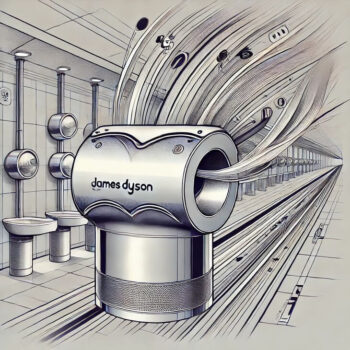 James Dyson, the inventor and founder of Dyson Ltd., revolutionized the building product space with his development of the Dyson Airblade hand dryer. Traditional hand dryers were slow, inefficient, and often unsanitary. Dyson introduced the Airblade in 2006, which used powerful air streams to dry hands in just 10 seconds, while also being more energy-efficient and hygienic. Dyson’s innovation started a trend in public restroom design toward more sanitary, touchless, and environmentally-friendly options, leading to the wider adoption of high-speed hand dryers across commercial spaces.
James Dyson, the inventor and founder of Dyson Ltd., revolutionized the building product space with his development of the Dyson Airblade hand dryer. Traditional hand dryers were slow, inefficient, and often unsanitary. Dyson introduced the Airblade in 2006, which used powerful air streams to dry hands in just 10 seconds, while also being more energy-efficient and hygienic. Dyson’s innovation started a trend in public restroom design toward more sanitary, touchless, and environmentally-friendly options, leading to the wider adoption of high-speed hand dryers across commercial spaces.
2. Elon Musk and Solar Roofing
 Elon Musk, through Tesla Energy, introduced the Solar Roof in 2016, a product that transformed the way people think about solar energy and roofing materials. Rather than traditional bulky solar panels mounted on top of roofs, Musk’s Solar Roof is made of sleek, glass tiles that generate electricity while maintaining the appearance of a conventional roof. This innovation started a trend toward aesthetically pleasing, integrated solar products in building design, appealing to homeowners who wanted clean energy without sacrificing visual appeal. The concept of integrating energy generation into the core structure of buildings has since gained traction in sustainable architecture.
Elon Musk, through Tesla Energy, introduced the Solar Roof in 2016, a product that transformed the way people think about solar energy and roofing materials. Rather than traditional bulky solar panels mounted on top of roofs, Musk’s Solar Roof is made of sleek, glass tiles that generate electricity while maintaining the appearance of a conventional roof. This innovation started a trend toward aesthetically pleasing, integrated solar products in building design, appealing to homeowners who wanted clean energy without sacrificing visual appeal. The concept of integrating energy generation into the core structure of buildings has since gained traction in sustainable architecture.
3. Sarah Susanka and the “Not So Big House” Movement
Architect and author Sarah Susanka started a major trend in home design with her 1998 book The Not So Big House. Susanka advocated for the idea that smaller, well-designed homes focused on quality over quantity could better meet homeowners’ needs than oversized, inefficient houses. This movement toward downsizing and more thoughtful use of space anticipated trends like tiny homes and minimalist design. Her philosophy changed how builders and architects approached residential design, focusing on functional, livable spaces rather than simply maximizing square footage. This shift influenced trends toward open floor plans, flexible spaces, and personalized, smaller-scale homes.
4. Steve Glenn and Prefabricated Sustainable Homes
Steve Glenn, founder and CEO of Plant Prefab, pioneered the concept of eco-friendly, prefabricated homes. In 2006, he launched the company with a focus on sustainable building materials, energy-efficient systems, and rapid, modular construction. While prefabricated homes had existed before, Glenn’s vision for combining prefabrication with sustainable, luxury design set a new standard. His company has built homes for high-profile clients like Leonardo DiCaprio, and Plant Prefab’s innovative approach started a trend toward modular, sustainable housing, which is now a growing sector in the construction industry.
5. Frank Lloyd Wright and Open-Plan Living
Though Frank Lloyd Wright is best known as one of the greatest architects of the 20th century, his innovative use of the open floor plan in residential homes profoundly influenced building design trends. Wright pioneered the idea of eliminating formal separations between rooms—particularly between the kitchen, dining room, and living room—in the early 1900s, a design approach that didn’t become mainstream until decades later. His work laid the foundation for what has become a staple in modern residential construction: open-plan living. Today, the open floor plan is nearly ubiquitous in both new home designs and renovations, emphasizing light, space, and multifunctionality.
6. Geberit and Concealed Cisterns
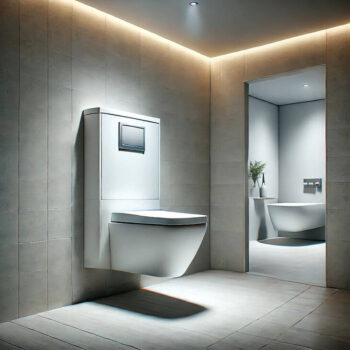 Geberit, a Swiss manufacturer, played a crucial role in starting the trend toward concealed cisterns in bathrooms. In the early 1980s, Geberit introduced concealed flushing systems, which hide the toilet tank inside the wall, creating a sleeker and more minimalistic bathroom appearance. This innovation not only improved aesthetics but also helped save space in small bathrooms, paving the way for modern, minimalist bathroom designs. Today, concealed cisterns are a standard in luxury bathroom design, significantly influencing the trend toward cleaner lines and uncluttered spaces in contemporary architecture.
Geberit, a Swiss manufacturer, played a crucial role in starting the trend toward concealed cisterns in bathrooms. In the early 1980s, Geberit introduced concealed flushing systems, which hide the toilet tank inside the wall, creating a sleeker and more minimalistic bathroom appearance. This innovation not only improved aesthetics but also helped save space in small bathrooms, paving the way for modern, minimalist bathroom designs. Today, concealed cisterns are a standard in luxury bathroom design, significantly influencing the trend toward cleaner lines and uncluttered spaces in contemporary architecture.
7. Antonio Citterio and the Luxury Kitchen Trend
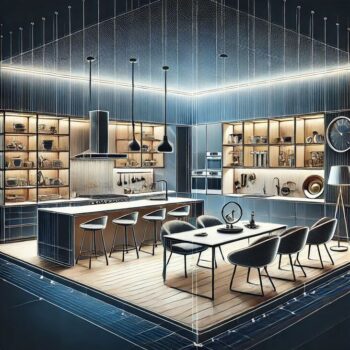 Italian architect and designer Antonio Citterio helped popularize the trend of integrating luxury design elements into kitchen spaces. Collaborating with companies like Arclinea, he designed high-end, functional kitchens that emphasized sleek lines, professional-grade appliances, and innovative storage solutions. His influence spurred a trend where the kitchen was no longer just a functional area but a central, high-design space in the home. The trend toward luxury kitchens, featuring premium materials like stainless steel, stone countertops, and integrated appliances, has become a staple in modern residential design.
Italian architect and designer Antonio Citterio helped popularize the trend of integrating luxury design elements into kitchen spaces. Collaborating with companies like Arclinea, he designed high-end, functional kitchens that emphasized sleek lines, professional-grade appliances, and innovative storage solutions. His influence spurred a trend where the kitchen was no longer just a functional area but a central, high-design space in the home. The trend toward luxury kitchens, featuring premium materials like stainless steel, stone countertops, and integrated appliances, has become a staple in modern residential design.
8. Philippe Starck and the Designer Bathroom
French designer Philippe Starck transformed the bathroom into a space for luxury and artistry. His collaborations with Duravit in the 1990s brought minimalist, high-end design into bathroom products, such as sinks, bathtubs, and toilets. Starck’s influence turned the bathroom from a purely utilitarian space into one of high design, inspiring trends that embraced sleek fixtures, freestanding bathtubs, and the use of modern materials like glass and metal. This movement set the stage for today’s emphasis on designer bathrooms as spaces of comfort, relaxation, and style.
In summary, while trends often gain traction through collective adoption, individuals with the right mix of innovation, visibility, and influence can indeed ignite movements that turn into larger trends. Whether it’s through a groundbreaking product, a personal style choice, or a new way of thinking, a single person can spark change that spreads widely.
Perhaps Natalia Pierce summed it up in the KCMA webinar when she was asked what’s the most important thing to ask when you are designing a kitchen space? She said, “What do you want in a kitchen? I often ask what doesn’t work rather than what you want. I ask what they hate about it, that is the big key and pain points. The second thing I focus on is understanding type of user that they are. Do they do big batch cooking? I need to understand what the kitchen needs to do because it makes a difference on solutions. Are their aging parents? Children? Understanding the space in general, family dynamics and create solutions for longevity is the key.”
In other words, she bends the trends to the needs of a customer to create something that’s truly unique, innovative, and functional. Perhaps that’s something we should all be doing.
[1] Sustainable fashion: challenges and barriers for advancing the circular economy. January 2023. Environment Development and Sustainability.
[2] Actually, the tiny house movement trend is already gone. Eve Andrews writes What Ever Happened to the Tiny House Movement? In Wired magazine that tiny houses started as a minimalist revolution but ended up as an Instagram aesthetic.
[4] “Now, designers and brands can offer one-of-a-kind pieces to their customers. This shift is changing how clothes are made and letting shoppers enjoy a custom fit.” in The Rise of 3D Printing in Custom Apparel Manufacturing.
[5] But already, BIM is confronting AI and the inability of humans to keep up with technology. Looking ahead to 2025, Harkunwar Singh writes in BIM and Augmented Reality: Bridging the Gap Between Design and Construction that “the non-residential AEC industry will utilize US$950 million in design and construction and US$400 million in operation and maintenance phases. This leaves us with the rising demand for BIM in construction outstripping the number of available professionals.” So who will set the trends – humans or ??
[6] The personal luxury market’s explosive growth from 2019 through 2023 was up almost 30% over the four years. However, in 2023 luxury advanced only about 4% to $387 billion in revenue. The key word is “only” isn’t it? $387 Billion Luxury Market Remains Turbulent. Here Are The Bright Spots by Pamela N. Danziger.
[7] ASID’s 2023 Economic Report noted high interest rates and a possible recession in 2023 could mean downward pressure on interior design services employment in the remainder of 2023 and into 2024. Well, it’s already the end of 2024 and people still debate if there’s a recession or not. The point is that gathering data is important, but a business HAS to make its own evaluation on the strategy of trending.
[8] For example, the U.S. Added 818,000 Fewer Jobs Than Reported Earlier according to the Labor Department revised figures for the 12 months through March, pointing to greater economic fragility. These kinds of errors throw doubt across the board about the conditions businesses operate in.
[9] Brutalism is an architectural style characterized by large, block-like structures made of exposed concrete, often with a raw and unfinished aesthetic, showcasing the building’s structural elements rather than decorative design. In The 24 Most Beautiful Brutalist Buildings in the World, Jessica Cherner and Elizabeth Stamp give us some examples.
About James A. Nowakowski.
 James A. Nowakowski has been a business strategist, speaker, and author since starting his companies (www.interlinegroup.com and a-i-m.com) in 1990. He taught English for 10 years in private and public schools in the Chicago area prior to that, and holds an M.A. in English from DePaul University, and a B.A. from Lewis University where he majored in English and minored in Theology and Philosophy. For his M.A., Nowakowski passed two of his four comprehensive examinations with distinction (Renaissance and American Literature). Jim has used his classical training throughout his business career, which can be examined in his blog, Alas, poor Yorick! Do you know him? There, Jim was invited to participate on an Industry Advisory Council (IAC) panel held by the University of Phoenix College of Humanities and Sciences on November 13, 2015. He grew his business to over twenty-five people prior to COVID and remains active in his businesses which are in Palatine, Illinois. He can be found on LinkedIn at: https://www.linkedin.com/in/jim-nowakowski-a1aa0b26/ on X at @interlinejim or email: [email protected].
James A. Nowakowski has been a business strategist, speaker, and author since starting his companies (www.interlinegroup.com and a-i-m.com) in 1990. He taught English for 10 years in private and public schools in the Chicago area prior to that, and holds an M.A. in English from DePaul University, and a B.A. from Lewis University where he majored in English and minored in Theology and Philosophy. For his M.A., Nowakowski passed two of his four comprehensive examinations with distinction (Renaissance and American Literature). Jim has used his classical training throughout his business career, which can be examined in his blog, Alas, poor Yorick! Do you know him? There, Jim was invited to participate on an Industry Advisory Council (IAC) panel held by the University of Phoenix College of Humanities and Sciences on November 13, 2015. He grew his business to over twenty-five people prior to COVID and remains active in his businesses which are in Palatine, Illinois. He can be found on LinkedIn at: https://www.linkedin.com/in/jim-nowakowski-a1aa0b26/ on X at @interlinejim or email: [email protected].